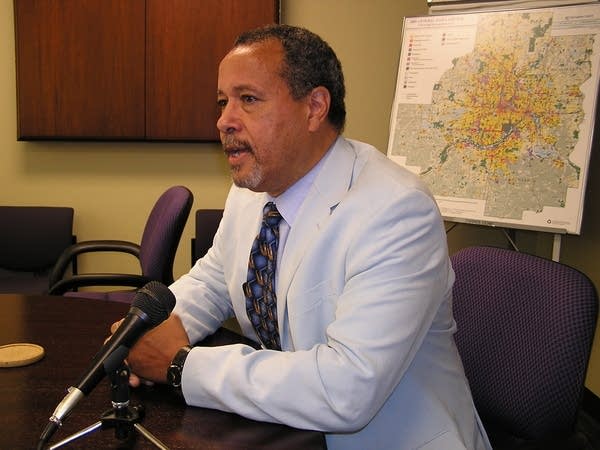Met Council aims to trim price tag of University Avenue LRT
Go Deeper.
Create an account or log in to save stories.
Like this?
Thanks for liking this story! We have added it to a list of your favorite stories.

The Met Council is asking the Federal Transit Administration to pay half the cost of the Central Corridor University Avenue light rail project. Metropolitan Council chairman Peter Bell thinks the FTA is more willing to fund a line that costs around $840 million than the current estimated $1 billion price tag.
Bell says one question that needs an answer is the connection to St. Paul's historic Union Depot in Lowertown.
"Are we going to go to the depot, and if we do are we going go to the front of the depot or the back of the depot?"

Met Council officials say they do not have firm numbers on some of the proposed trims to the construction budget. They estimate holding off building the line all the way to depot could reduce costs by a few million.
Turn Up Your Support
MPR News helps you turn down the noise and build shared understanding. Turn up your support for this public resource and keep trusted journalism accessible to all.
However, the Met Council is feeling pressure on the issue from east metro counties.
Ramsey County Commissioner Rafael Ortega says delaying building the light rail line all the way to the depot may delay other transit projects which would use the depot as a central station for a Twin Cities transit system.
"Dakota County, Washington County, all their future planning or projection of lines or corridors of transportation they would like to see regardless of the mode link, especially if it's light rail, to the depot."
Another question is how much excavation to do when rails are laid in St. Paul along University Avenue. Some argue it is an opportunity to dig deeper and wider and replace aging pipes and other services buried under the street that'll have to be replaced at some point anyway.

The more extensive streetscaping, as it is called, costs more. The Met Council's Peter Bell says there may be alternatives to help pay those costs.
"That also might be something that Ramsey county or the city of St. Paul could underwrite," he says.
Then there is the tunnel.
The proposed Central Corridor light rail line would carry riders 11 miles between downtown St. Paul and Minneapolis through the University of Minnesota's Minneapolis campus. One scenario has the line enter a tunnel to run below Washington Avenue near the campus.
The tunnel's price tag is about $155 million.
Why a tunnel?
The U of M's vice president for administration, Kathleen O'Brien, says a train running on Washington Avenue would cause a lot of congestion as it competes for space with vehicles including buses. O'Brien says the U wants a tunnel to avoid creating more congestion.
"There's about 1,600 buses a day on University Avenue as well as thousands of trips by emergency vehicles and people with emergency medical care to the University of Minnesota hospital and clinics everyday," she says.

There may be an alternative to building an expensive tunnel below Washington Avenue. The U and the Met Council have agreed to study building the line further north and closer to Dinkytown.
That would send the trains over the Mississippi River to downtown Minneapolis on the 10th Avenue bridge or another span.
U officials are not taking a backseat in Central Corridor planning because, Kathleen O'Brien says, many of the riders will be U faculty, staff and students.
"The projections for the Central Corridor illustrate the University will be close to one-third the ridership on the line," she says.
There are lots of other questions besides the depot connection, infrastructure improvements below University Avenue in St. Paul and the tunnel.
Some neighborhood residents, for example, want more light rail stations built closer together.
The Met Council is scheduled to act on how the Central Corridor University Avenue light rail line should be built at a meeting on February 27. There are lots of public meetings and information sessions scheduled where people can discuss the questions before the February meeting.




